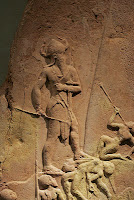Cerialia and the fire fox.
The star of Erra is shining bright...
The roman festival of Ceres was one of the oldest festivals. It is listed in capital letters in the pre-Julian calander of the Roman republic. This is dated to between 753 - 509 B.C. The priest of her cult, the flamen Cerealis belonged to the most ancient class of priests, the flaminate, whose foundation was ascribed to Numa -the second king of Rome.
The word flamen is interesting, so close to flame...not everyone thinks so. From Wiki:
On the evening of April 19th flaming torches were tied to the tails of foxes, these were released into the arena of the Circus Maximus... Ovid describes the ritual as stemming from an incident in which a boy caught a fox:
The Ludi Ceriales, were consecrated to Ceres in 202 BC. The Ludi Ceriales or "Games of Ceres" were held as part of the festival in the Circus Maximus. Ovid mentions that Ceres' search for her lost daughter Proserpina was represented by women clothed in white, running about with lighted torches..
The Circus Maximus was the the first and largest stadium in Rome, able to accommodate over 150,000 spectators, at the southeastern turning-post of the race track there was an underground shrine to Consus, a god of grain-stores, which modern writers have connected to the grain-goddess Ceres and to the underworld because it would be very tempting to think that this was the location of the mundus Cereris...
Festus mentions mundus - a vaulted subterranean shrine....and Plutarch believed the mundus to be of Etruscan origin; he states that it was used as a place where first-fruits were deposited.
Festus, quoting Cato this time, explains that:
The ritual opening of the mundus took place on the 24 Aug, 5 Oct, and 8 Nov. When opened it allowed the Manes from the Underworld to receive offerings and to visit the upper world.
Who are the Manes?
Macrobius, quoting Varro, says of these days that:
There is another conjunction of foxes and fire
And in Judges 16 Samson -so close to Shamash wouldn't you say? - losing his strength when his solar locks are cut off by Delilah.
As Robertson Smith pointed out, rituals are usually done because they have always been done. People forget why. Then there is the theory that folk tales preserve ancient wisdom, but a test carried out to see how good oral history was at preserving key facts found that actually...oral history isn't very good at preserving facts at all. And yet...fox star (The bad sun - Mars), Samson (Shamash) and foxes seem to fit.
Another bit of the puzzle snaps together?
(I wish!)
The roman festival of Ceres was one of the oldest festivals. It is listed in capital letters in the pre-Julian calander of the Roman republic. This is dated to between 753 - 509 B.C. The priest of her cult, the flamen Cerealis belonged to the most ancient class of priests, the flaminate, whose foundation was ascribed to Numa -the second king of Rome.
The word flamen is interesting, so close to flame...not everyone thinks so. From Wiki:
The origin of the word flamen is as obscure as are some of the assigned gods. Sophus Bugge suggested in 1879 that flamen is from an older *flădmen and related to the Germanic blót. Both would be derived from a Proto-Indo-European word *bhlād(s)men. Indo-Europeanist Georges Dumézil attempted to link it to the Sanskrit word brahman. This etymology is still controversial.Ovid (March 43 BC – AD 17/18) tells us something of what happened at the Ceriales.
On the evening of April 19th flaming torches were tied to the tails of foxes, these were released into the arena of the Circus Maximus... Ovid describes the ritual as stemming from an incident in which a boy caught a fox:
long ago, at ancient Carleoli, a farm-boy caught a fox stealing chickens and tried to burn it alive. The fox escaped, ablaze; in its flight it fired the fields and their crops, which were sacred to Ceres. Ever since, foxes are punished at her festivalBut that is unlikely to be why foxes and fire.
The Ludi Ceriales, were consecrated to Ceres in 202 BC. The Ludi Ceriales or "Games of Ceres" were held as part of the festival in the Circus Maximus. Ovid mentions that Ceres' search for her lost daughter Proserpina was represented by women clothed in white, running about with lighted torches..
The Circus Maximus was the the first and largest stadium in Rome, able to accommodate over 150,000 spectators, at the southeastern turning-post of the race track there was an underground shrine to Consus, a god of grain-stores, which modern writers have connected to the grain-goddess Ceres and to the underworld because it would be very tempting to think that this was the location of the mundus Cereris...
Festus mentions mundus - a vaulted subterranean shrine....and Plutarch believed the mundus to be of Etruscan origin; he states that it was used as a place where first-fruits were deposited.
Festus, quoting Cato this time, explains that:
Mundo nomen impositum est ab eo mundo qui supra nos est.And so the word is translated as 'world', and yet, this does not seem to fit, I suppose because I think of the world as all of it: heaven, earth and hell..
(The mundus gets its name from that world which is above us.)...
The ritual opening of the mundus took place on the 24 Aug, 5 Oct, and 8 Nov. When opened it allowed the Manes from the Underworld to receive offerings and to visit the upper world.
Who are the Manes?
"Apuleius says, indeed, that the souls of men are demons, and that men become Lares if they are good, Lemures or Larvae if they are bad, and Manes if it is uncertain whether they deserve well or ill.
For, however wicked men have been, if they suppose they shall become Larvae or divine Manes, they will become the worse the more love they have for inflicting injury; for, as the Larvae are hurtful demons made out of wicked men, these men must suppose that after death they will be invoked with sacrifices and divine honors that they may inflict injuries. But this question we must not pursue. He also states that the blessed are called in Greek eudaimones, because they are good souls, that is to say, good demons, confirming his opinion that the souls of men are demons."We are back to the Deveni papyrus here, a lot of the papyrus seems to be a debate about the nature of the Erinyes/ Eumenides, not as semi-divine servants of justice, but as guilty, unhappy souls of the dead.
— City of God, Book IX, Chapter 11
Macrobius, quoting Varro, says of these days that:
Mundus cum patet, deorum tristium atque inferum quasi ianua patet.Back to the foxes...
("When the mundus is open, it is as if a door stands open for the sorrowful gods of the underworld.")
There is another conjunction of foxes and fire
And Samson went and caught three hundred foxes, and took firebrands, and turned tail to tail, and put a firebrand in the midst between two tails. And when he had set the brands on fire, he let them go into the standing corn of the Philistines, and burnt up both the shocks, and also the standing corn, with the vineyards and olives.Then the Philistines said, Who hath done this? And they answered, Samson, the son in law of the Timnite, because he had taken his wife, and given her to his companion. And the Philistines came up, and burnt her and her father with fire. And Samson said unto them, Though ye have done this, yet will I be avenged of you, and after that I will cease.
And he smote them hip and thigh with a great slaughter: and he went down and dwelt in the top of the rock Etam. Judges 15
And in Judges 16 Samson -so close to Shamash wouldn't you say? - losing his strength when his solar locks are cut off by Delilah.
As Robertson Smith pointed out, rituals are usually done because they have always been done. People forget why. Then there is the theory that folk tales preserve ancient wisdom, but a test carried out to see how good oral history was at preserving key facts found that actually...oral history isn't very good at preserving facts at all. And yet...fox star (The bad sun - Mars), Samson (Shamash) and foxes seem to fit.
Another bit of the puzzle snaps together?
(I wish!)


